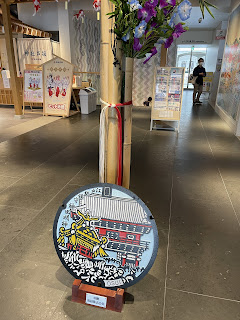At Akhihabara area, I was resolved to visit Kanda shrine or Kanda-myojin (神田明神). At early July it is also hosting an special exhibition by brush-master Masayuki Kojo, a well-known warrior painter. Kanda shrine has been an important shrine especially for warrior class (Japanese samurai) and common folks. It is said that during Edo period, even Tokugawa Ieyasu shogun even paid respect to this shrine.
Firstly, navigating the large Akihabara station is amazing.
Over a sturdy stone bridge on a sunny summer afternoon, I learned the bridge was built on early 20th century and named. Next to it there is a quiet shrine dedicated to Confusius that is set on a rocky green space.
Kanda shrine is one of the oldest temple in Tokyo. It hosted a couple deities, especially for students and mechants.
At the gate, you will find many visitors starting to pay respect to the sacred ground. A good way to pay respect is to bow, either with slight incline of head or, should you prefer, a proper bow from the waist.
This is the main gate of the shrine which is two-storey high.
The shrine hosted three Japanese deities or kami: Daikokuten, Ebisu, and Taira no Masakado. Daikokuten is the deity of fortune and wealth (also household, fertility, and war) and is well known to be holding a big golden mallet and a sack or bag; I observed a long line to pay respect even on a weekend morning.
This site to honor Ebisu is in the form of child who drifted in the sea. It is located on the left side from entrance. Ebisu is thus the god protector of fishermen and businessmen.
The temple ground peculiarly hosted a small pony. And the pony while missing on Saturday afternoon, was sunbathing on the Sunday morning when I revisited again.
Given the proximities to the electronics town Akihabara which also known
as geek paradise, this shrine is known to be an anime shrine and even
has anime character as its guardian angel. A few exhibit showed numerous
anime which was set on this shrine and some of the characters who is
the miko or the temple maiden and similarly traditionally attired
gentlemen whom I assume as priests.
A number of spots on the shrine ground naturally became the setting for anime, especially the ground, the main building, the eastern-side staircase, and the gates.
One of popular activities on a Japanese shrine is to divine your fortune of the year as well as making wishes by writing them on a wooden tablet, in Japanese ema. The tablet is then dedicated to gods by hanging it on the shrine ground. Here is an information site to learn more about this custom: Make a wish at a Shrine: How to dedicate an Ema tablet.
This is the first time that I am seeing manga drawing on this wooden board! They are either printed or hand-drawn by some talented people. Look at this! amazing!
Ema (絵馬) original word is from horse 馬, meaning 'picture/drawn horse' in Japanese. Is this the reason why there was a pony on the shrine ground, next to the dedicated area?
The exhibition area was quiet when I visited on Sunday morning. There was special exhibition celebrating 10th anniversary of Masayuki Kojo, who is well-known as painter of warriors. The exhibition focuses on the third deities hosted in the shrine: Taira no Masakado.
Entrance area where phototaking was permitted:
This is modern rendition of a traditional Japanese painting:
Some great-size brush painting was displayed.
Level 1 also featured some colorful brushwork arts.
Other than the special exhibition, there was normal exhibition of the temple items over 2 storey area. The second floor area was prohibited for photo-taking.
Some diorama featuring the vehicle/carriage that is normally used during religious festival. This carriage is literally portable shrine or mikoshi, and is paraded during a large festival, in Kanda celebrated in odd years Kanda matsuri.
Walking the inner area that was ticketed while it was quiet and devoid of many tourist, was strangely relaxing. I took a fast-forward version of the walkway.
Anime themed display;
Also the stairways.
Japan is known for its designed manhole cover. Such as this one depicting the shrine.
After visiting the exhibition, I got hungry and a popular cafe is located indoor at the temple shop area.
The udon with grated yam totoro, is delicious.
A closer look at the udon with its runny egg yolk. In Japan the eggs were produced and transported with highest hygiene standard befitting a country whom loved its produce in original form and taste. Thus you feel safe even to consume raw items.
The cafe has minimalistic nature-inspired design, and a such chic place to chill out and enjoy a moment.
The cafe is also famous for its inari sushi Japanese tofu-pocket sushi made of tofu skin wrapping a handful of sushi rice inside. The shrine does host an Inari, the fox deity.
The vast shrine ground is hosting many smaller shrines honoring various sacred items and deities according to Japanese belief.




























